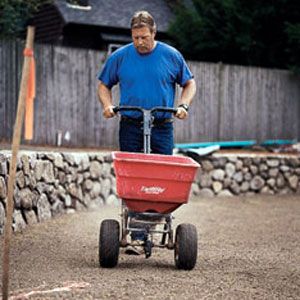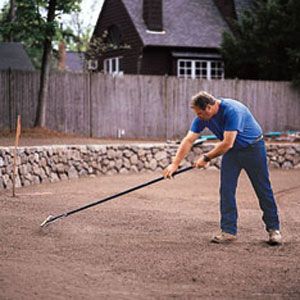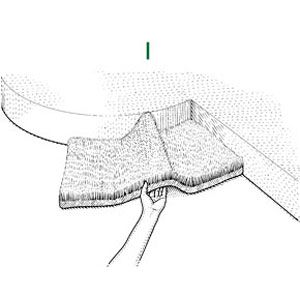Laying sod is a great way to get a lush, green lawn quickly. While it requires some manual effort, this project can transform your yard in just a few days. Our guide will walk you through the process of preparing your soil and laying sod. This Old House landscape contractor Roger Cook shares expert tips in the video above.
When Is the Best Time To Lay Sod?
You can install sod from spring through fall in most regions, and even in the winter in mild climates. Each season has advantages depending on your climate and lawn type:
- In cooler climates, laying sod in spring helps reduce weed competition. The moderate temperatures allow the sod to establish roots before the heat of summer.
- For warm-season grasses in southern states, you can lay sod year-round. Cooler fall and winter months offer relief from the intense summer heat, making the work more comfortable.
Keep in mind that different sod types thrive best when installed during their ideal growing conditions. For instance, warm-season grasses usually perform better when laid in late spring or early summer.
Put aside a few weekends to handle this project. For either soil preparation or sod laying, we estimate that two people can cover around 1,000 square feet in a single day. Count on one weekend to prepare the soil for sod and another to lay the turf.
How Much Does Sod Installation Cost?
It costs $300–$900 to cover a 1,000-square-foot backyard (double that if you’re having it installed), based on pricing from local turf stores. Always check to see if a store offers bulk discounts. “You’re basically buying time,” says Cook. “You’re paying for turf that someone else has coddled for 14–18 months.”
Where Can You Buy Sod?
Depending on where you live, you can order sod from a garden center or directly from a sod farm. It will generally be a mix of two or three turf grasses chosen for optimal color, texture, and heartiness. Be sure to tell your supplier if your yard’s in partial or full shade.
You want your sod to be delivered within 24 hours of being cut, and you should lay it the same day. Measure your yard carefully so you order the right amount, with some overage (about 5%) to account for cutting around curves.
How Do You Prepare Your Soil for Sod?
“Sometimes sod gets a bad rap, but that’s usually because of mistakes people make while laying it,” says Cook. “Put down on properly prepared soil, it will thrive.”
Removing Existing Grass
Remove any existing grass or vegetation. Remove only the top layer of grass and roots, not the underlying soil. Cook recommends renting a grub hoe, as its blade efficiently strips off the top layer of grass.
Loosening the Soil
Turf likes a nutrient-rich, well-aerated base that’s slightly acidic (with a pH between 6.0 and 7.5). Now it’s time to loosen the soil. Break up the top 6–8 inches of soil. This helps create a loose, fertile bed for your new sod to root into. Unless you’re working in a small area, Cook suggests renting a rototiller. Set the wheels and the tines to forward and the throttle to halfway for the best results.
Soil Testing
We recommend testing your soil before laying the sod. You can test your soil any time throughout the year, but the best time to test is in the spring or fall. To collect a good sample, dig at least five holes that are six inches deep by two inches wide in various spots in your yard. As you go, avoid or remove any grass, weeds, thatch, or roots. Mix all the samples together, then put about 2 cups of the mix into a zip-seal bag.
A do-it-yourself kit will tell you the pH and levels of crucial nutrients (nitrogen, potassium, phosphorus). But for the most accurate and complete results, have your soil tested by your county extension service or state university. They’ll analyze a soil sample and send you a report detailing pH, texture, nutrient levels, and recommended corrections.
The more information you give with the sample, the more useful its recommendations will be. Note thing like what kind of turf grass you’ll be using; whether the yard gets lots of shade, sun, or foot traffic; or if construction has recently disturbed the soil. Remember that it takes some time to get the results and correct your soil—don’t leave it until the last minute.
Adding Amendments

Make necessary adjustments based on your soil test results. In the video, Cook adds starter fertilizer and lime. Lime helps to decrease soil acidity, creating a more hospitable environment for sod to thrive.
Spread a two-inch layer of finished compost over the area. This organic matter improves soil structure, drainage, and nutrient content. Till into the soil thoroughly to mix in the compost, allowing for an even distribution of nutrients and better drainage.
Rough Grading

Use an iron rake to knock down high spots and fill in low areas. The goal is to create a level surface that’s about an inch below the grade of any paved surfaces, such as walkways or driveways. Position the rake head at 90 degrees to move large amounts of soil, and adjust the angle slightly for precision in smaller areas.
Fine Grading
Use the back of the rake to smooth out the surface. This creates an ideal base for laying sod. Fine-tuning the soil surface helps the sod have good contact with the soil beneath, reducing air pockets that can hinder roots.
How Do You Lay Sod?
With your soil prepared, it’s time to lay the sod. This requires close attention to detail for even coverage.
Starting the First Row
Begin laying sod along the longest straight edge in your yard, such as a fence line or driveway. Unroll the first piece of sod, making sure it’s flat against the soil with no air pockets, and rake out footprints as you go. Starting with a straight line makes the rest of the installation much easier. Cook tucks his first row right up along the fence.
Laying Subsequent Rows
For the second row, stagger the short seams by cutting the first piece in half. This creates a brick-like pattern and keeps seams from lining up. Butt each piece of sod snugly against its neighbors without overlapping. This helps the rows knit together and makes the edges less likely to dry out and die back.
Handling Curves and Edges

When laying sod around curves, use a sharp knife to cut the sod to fit. Cook uses a technique that involves slicing in the sod using a snap-off razor knife. He makes his sod curve the way a tailor might, by cutting a dart or two in a full-sized piece.
With the sod laid next to the curve, he grabs a couple of spots along one edge and pieces them together to make the sod follow the contours of the bed. This creates a triangular upward fold that he slices down its crease with a razor knife. One side of the cut goes down against the ground; he lays the other flap on top of it. Using the cut edge of this flap as a guide, he saws the knife through the sod and removes the triangular piece underneath. Now, the flaps meet and the cut disappears.
Some people cut the sod lengthwise into strips to bend around a curve, but Cook says smaller pieces like that are more likely to dry out and die than ones that remain full-width.
Addressing Unevenness
Address any unevenness or footprints in the sod by gently lifting and adjusting the sod pieces. Fill low spots with soil as needed. This helps the sod establish roots more effectively and creates a plush, consistent lawn.
When Can I Walk on My Sod?
We recommend keeping foot traffic off your new sod for about a week to reduce the risk of damage while the sod is still taking root. If you need to walk on your sod to care for it (see below), try to walk only on small sections, and don’t stay longer than you need to.
How To Properly Water and Care For Your New Sod Lawn
Proper watering is central to the success of your new sod lawn.
Initial Watering
Water the newly installed sod thoroughly immediately after laying. This helps settle the soil and creates contact between the sod and the soil beneath. Generous watering from the start helps the sod acclimate to its new environment and kick-start root growth.
Ongoing Watering Schedule
Cook’s recommended watering schedule for new sod is as follows:
- Week 1: Water daily, preferably in the morning. This helps the sod stay hydrated while it adjusts to the new soil.
- Week 2: Water every other day. Gradually reduce the frequency while maintaining the same amount of water to help the roots start to seek water deeper in the soil.
- Week 3: By this point, taper back watering to twice a week.
- Week 4 and beyond: Provide about an inch of water per week along with the rest of your lawn.
Mowing and Fertilizing
Wait until the grass is three inches tall before you mow it for the first time. Cut it down to two inches using a walk-behind mower. A higher initial cut helps establish strong roots and reduces stress on the sod. Going forward, aim to cut off a third of the grass’s length anytime you mow and be sure to use a sharp blade.
After three or four weeks, apply a starter fertilizer to replenish nutrients lost during the initial heavy watering period.
Tips From Sod Farmers
Here’s some advice from the pros for your DIY sod installation:
- Because sod is perishable and dries out quickly, many farmers cut their turf in the middle of the night so that it can be delivered and installed the same day. To keep it moist, consider watering the sod after you lay the first large area and move the sprinkler around the lawn as you complete each subsequent section.
- Even sod farmers can’t tell how moist soil is by looking at a lawn. Use a soil probe (many types are available at home and garden centers) to check moisture levels. After a thorough watering, soil should be damp 3–4 inches below the surface.
- Strong turf needs plenty of sun; shade-grown grass is weaker and more susceptible to disease since it stays covered with dew longer. Water shady spots less often and reduce fertilizer by 25%.
